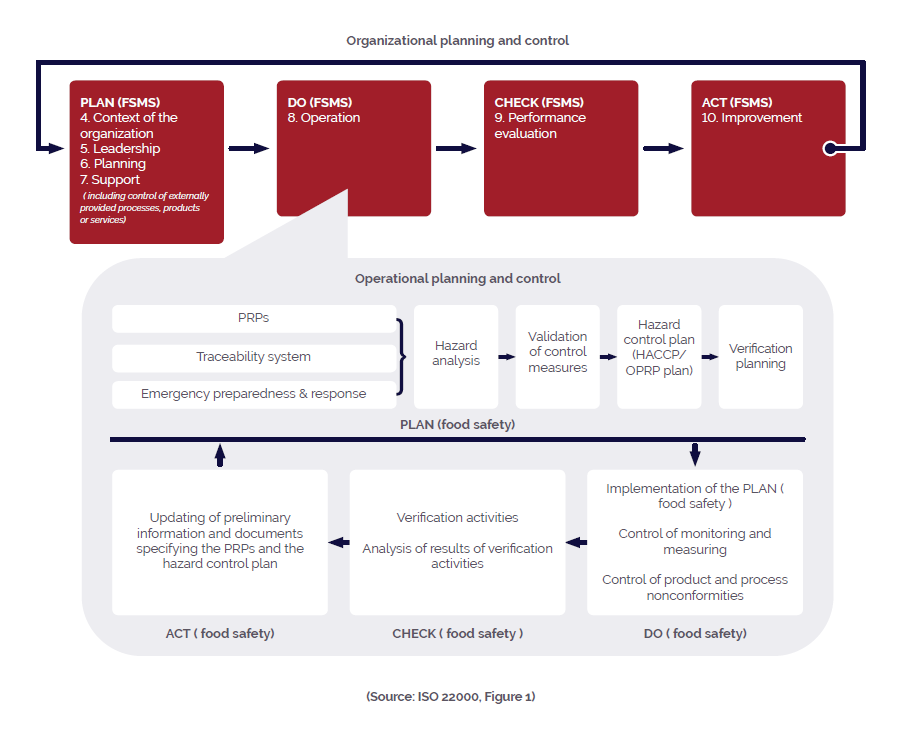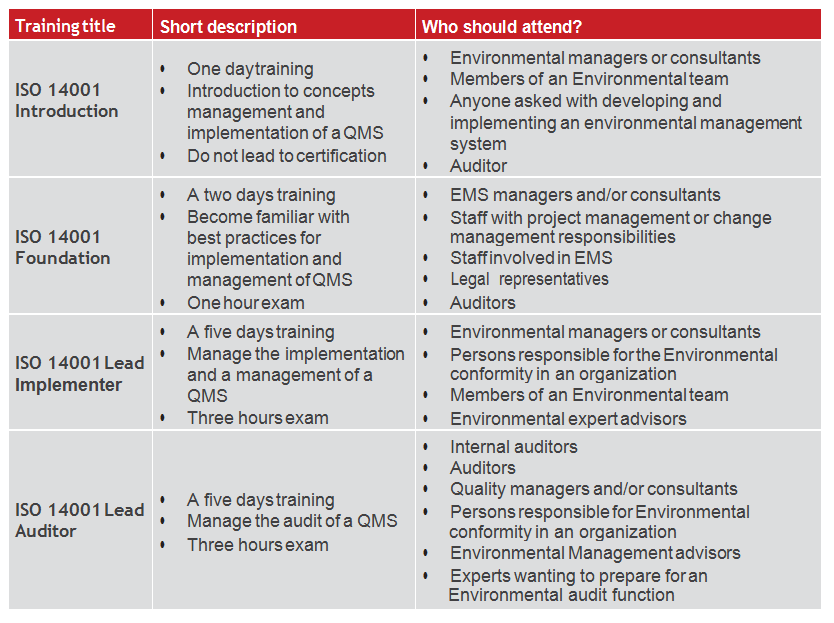The transitioning process from ISO/IEC 27001:2013 to ISO/IEC 2....
ISO 14001:2004 - Environmental Management System

Introduction

An overview of ISO 14001:2004
- Plan: establish the objectives and processes necessary to deliver results in accordance with the organization's environmental policy.
- Do: implement the processes.
- Check: monitor and measure processes against environmental policy, objectives, targets, legal and other requirements, and report the results.
- Act: take actions to continually improve performance of the environmental management system.
Environmental management is improved with ISO 14001 by incorporating
- An operational EMS applicable to any organization wishing to increase the effectiveness and efficiency of its processes related to environmental management;
- Feasible environmental policy and planning, with the aim to ensure the sustainable environmental management;
- Clearly defined measurable and practicable objectives and targets that are in cohesion with legal and other requirements; and
- Management commitment and defined resources, roles, responsibilities and authority.
ISO 14001 applies to all types and sizes of organizations that wish to:
- Establish, implement, maintain and improve an EMS;
- Improve practices to reduce the environmental impacts;
- Assure compliance with national, regional and international laws and treaties;
- Increase confidence of clients, business partners and other interested parties; and
- Make a self-determination and self-declaration of conformity with this International Standard.
Key clauses of ISO 14001:2004
ISO 14001 is organized into the following main clauses:
Clause 4.1: General requirements
Clause 4.2: Environmental Policy
- Is appropriate to the nature, scale and environmental impacts of its activities, products and services;
- Includes a commitment to continual improvement and prevention of pollution;
- Includes a commitment to comply with applicable legal requirements and with other requirements to which the organization subscribes which relate to its environmental aspects;
- Provides a framework for setting and reviewing environmental objectives and targets;
- Is documented, implemented and maintained;
- Is communicated to all persons working for or on behalf of the organization; and
- Is available to the public.
Clause 4.3: Planning
- Energy resources and raw materials (coal, gas, oil);
- Air pollution from substances (carbon and sulphur dioxide, lead);
- Accidental releases (fires, smoke, toxic gases);
- Development of land, drainage, pest control, changes to natural habitats; and
- Products and by-product (pipes, energy efficiency, green IT).
- The designation of responsibility for achieving objectives and targets at relevant functions and levels of the organization; and
- The means and time-frame by which they are to be achieved.
Clause 4.4: Implementation and operation
- Human resources and specialized skills;
- Organizational infrastructure;
- Technology; and
- Financial resources.
- The importance of conformity with the environmental policy and procedures and with the requirements of the environmental management system;
- The significant environmental aspects and related actual or potential impacts associated with their work, and the environmental benefits of improved personal performance;
- Their roles and responsibilities in achieving conformity with the requirements of the environmental management system; and
- The potential consequences of departure from specified procedures.
- The environmental policy, objectives and targets;
- Description of the scope of the environmental management system;
- Description of the main elements of the environmental management system;
- Documents, including records, required by this international standard; and
- Documents, including records that ensure the effective planning, operation and control of processes.
Clause 4.5: Checking
Clause 4.6: Management review
- Results of internal audits and evaluations of compliance with legal requirements and with other requirements to which the organization subscribes;
- Communication(s) from external interested parties, including complaints;
- The environmental performance of the organization;
- The extent to which objectives and targets have been met;
- Status of corrective and preventive actions;
- Follow-up actions from previous management reviews;
- Changing circumstances, including developments in legal and other requirements related to its environmental aspects; and
- Recommendations for improvement.
Link between ISO 14001 and other standards
Link with other environmental management standards
- EMAS – Eco Management and Audit scheme
- ISO 50001 – Energy Management
- ISO 18601 - Packaging and the Environment
- ISO 29001 – Management for Oil and Gas
- British Standards Institute: BS 8555
- SSAE-16: Statement on Standards for Attestation Engagement
Link with ISO 9001
Integration with other management systems
- determining and applying objectives according to the organization’s habits and needs;
- upholding the objectives based on strong management commitment by monitoring and reviewing;
- documenting pertinent management system processes;
- regular ‘health-checks’ via internal or external audits; and
- gaining benefits through continual improvement as achieved by a regular management review.

Environmental management system - the business benefits
ISO 14001 was developed mainly to assist companies with a practice based framework for better management control. In addition to improvements in performance, organizations can gain a number of business benefits, including higher conformance with legislative and regulatory requirements and improved public image.

- Identification of cost savings with emphasis on resource, waste and energy management;
- Effective and efficient management of environmental risks;
- Demonstrable environmental commitment to stakeholders;
- Lowering the risk of losing investors and customers;
- Increasing the reputation of the organization in the community and beyond;
- Increasing the opportunities to access new markets;
- Reduction of costs related to insurance;
- Compliance to national, regional and international laws and regulations;
- Building trustful relationships with local and national authorities;
- Usage of the ISO 14001 as a marketing tool;
- Resource conservation; and
- Positioning the organization as an environmental leader.
Implementation of an EMS with IMS2 methodology

Certification of organizations
-
Implementation of the management system: Before being audited, a management system must be in operation for some time. Usually, the minimum time required by the certification bodies is 3 months.
-
Internal audit and review by top management: Before a management system can be certified, it must have had at least one internal audit report and one management review.
-
Selection of the certification body (registrar): Each organization can select the certification body (registrar) of its choice.
-
Pre-assessment audit (optional): An organization can choose to perform a pre-audit to identify any possible gap between its current management system and the requirements of the standard.
-
Stage 1 audit: A conformity review of the design of the management system. The main objective is to verify that the management system is designed to meet the requirements of the standard(s) and the objectives of the organization. It is recommended that at least some portion of the Stage 1 audit should be performed on-site at the organization’s premises.
-
Stage 2 audit (On-site visit): The Stage 2 audit objective is to evaluate whether the declared management system conforms to all requirements of the standard is actually being implemented in the organization and can support the organization in achieving its objectives. Stage 2 takes place at the site(s) of the organization’s sites(s) where the management system is implemented.
-
Follow-up audit (optional): If the auditee has non-conformities that require additional audit before being certified, the auditor will perform a follow-up visit to validate only the action plans linked to the non- conformities (usually one day).
-
Confirmation of registration: If the organization is compliant with the conditions of the standard, the Registrar confirms the registration and publishes the certificate.
-
Continual improvement and surveillance audits: Once an organization is registered, surveillance activities are conducted by the Certification Body to ensure that the management system still complies with the standard. The surveillance activities must include on-site visits (at least 1/year) that allow verifying the conformity of the certified client’s management system and can also include: investigations following a complaint, review of a website, a written request for follow-up, etc.
Training and certifications of professionals




